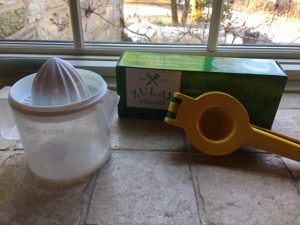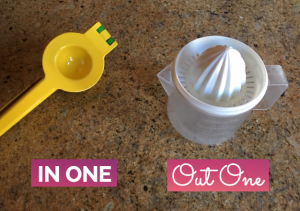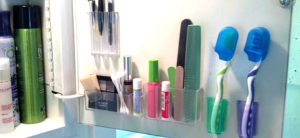If you’ve ever wondered, do organizers really practice what they preach?
I am here to say, YES! In my case, I follow 4 basic rules*:
1. Decide where things live
2. Return items to their “home”
3. Follow In One/Out One
4. Build routines around maintaining systems
 The third rule, In One/Out One, is the least appreciated and most neglected by our clients, even though it offers the best defense against clutter build-up.
The third rule, In One/Out One, is the least appreciated and most neglected by our clients, even though it offers the best defense against clutter build-up.
Here’s a personal story of how it recently went down in my house.
First you have to know that I LOVE citrus. Fresh lemon juice goes into every salad dressing. Fresh lime juice refreshes most fruit bowls. Many of my fish recipes require fresh lemon, lime or orange juice. So my juicer has been a staple in my kitchen. I love that it not only does a great job, it also attaches to a measuring cup – which makes it easy to know when I have enough.
Pictured below on the left, it had a primo spot in my most accessible gadget drawer just below my prep counter. Until…
 My husband, an aspiring minimalist, bought me a new juicer. He had researched to get me “the perfect gift.” I was skeptical, even though for him to buy something it MUST be great. I could not imagine HOW anything could replace my beloved juicer.
My husband, an aspiring minimalist, bought me a new juicer. He had researched to get me “the perfect gift.” I was skeptical, even though for him to buy something it MUST be great. I could not imagine HOW anything could replace my beloved juicer.
It would have to at least be:
• super easy to use
• simpler to clean
Well, my new citrus press is all that AND bold and bright. In being so colorful — I smile every time I see it.
 But it took me some time to let go of my trusted fave…2 weeks, in fact. I call it the testing time. Some “old” items deserve this reflective time.
But it took me some time to let go of my trusted fave…2 weeks, in fact. I call it the testing time. Some “old” items deserve this reflective time.
Honestly, it took me a week to open the package and try the new “citrus press.” I felt like I was cheating on my trusted go-to.
Once, I tried it, I set an alarm on my calendar to remind me to “consider if keeping new juicer” and a few days later “decide if still need old juicer.”
When you replace something, even if you are committed to In One Out One, you don’t HAVE to let go immediately. But you must put a time limit on making your decision. (It’s too easy for items to stagnate, clog your drawers and attract more clutter.)
Since I was using these gadgets daily, it didn’t take long to know I was in love. As for my “old” juicer, it still has life left in it. My son is a decent cook at college — so guess who just inherited a new fave? 🙂 When he graduates, I will gift him his very own citrus press!
* Remember I said these were 4 rules that I think every Professional Organizer follows?
It’s true of any organized person.
• You don’t have to be a professional organizer to be organized.
• Some people are MORE organized than their organizer (GASP!)
Yes…it’s true. Not every organizer is the MOST organized person you’ll ever meet.
• Professional Organizers know how to help YOU solve your organizational overwhelms and clutter-crisis.
This year’s Philadelphia Home Show has a theme of “Small Spaces”. With the recent trend of Tiny Homes, this theme seems a perfect fit. Besides, many residents of Philadelphia and its surrounding areas, without ever opting into the Tiny Home movement, have been faced with the challenges of tight spaces for decades.
At the show, visitors will get a chance to browse the latest home design concepts and  products. They can also get professional home improvement tips from presenters like Tyler Wisler from HGTV’s Design Star and Kevin O’Connor of This Old House. And, if that’s not reason enough to weather the cold, I will be joining several of my fellow Productivity & Organizing Professionals (NAPO) who will also be sharing their own tips, tricks and secrets for managing your spaces and living a clutter-free life.
products. They can also get professional home improvement tips from presenters like Tyler Wisler from HGTV’s Design Star and Kevin O’Connor of This Old House. And, if that’s not reason enough to weather the cold, I will be joining several of my fellow Productivity & Organizing Professionals (NAPO) who will also be sharing their own tips, tricks and secrets for managing your spaces and living a clutter-free life.
When it comes to busy lives and challenging spaces, organization and creativity are key. The more you are able to implement systems that address the challenges of your cramped space, the more freedom and control you will begin to feel. Imagine yourself having all your supplies neatly arranged and tidily stored so that there is no searching, digging, shuffling or juggling – each time you need them. Think of how quickly and easily you could come and go, with nary a look back, confident that all you are walking away from is in order. Ahhhh, the peace of it.
However, like the physical foundations our homes are built upon, a free and organized life needs a foundation in order to be sustainable. Sometimes this means adding organizational products in order to create a “home” for the items we use. Sometimes it means removing unnecessary excess from the environment. And, it almost always means having a set of basic foundational rules in place so that patterns can be formed and replicated.
So come on out! View the new trends and home solutions, attend a presentation or two and bring your own unique organizing challenge to an “Ask the Organizer” session to get personalized advice from a NAPO-GPC professional organizer!
WHEN: JANUARY 12–15 & 19-21, 2018
WHERE: PENNSYLVANIA CONVENTION CENTER, PHILADELPHIA, PA
Is it possible to live in a small area? You bet it is!
Most of us know people living in small houses or apartments, going to college and living in a dorm for the first time, or moving from a big home to a smaller one. Even if you don’t, you may have experienced one of these situations yourself at some point.
Did you feel challenged trying to fit everything in your new space? Does the person you know feel challenged trying to do the same thing?
If you follow these five (5) tips, it really is easier than you think:
1. Divide the space into specific areas for each activity (e.g., bill paying, watching TV, hobbies, laundry, reading, or studying). Furniture and rugs can be used to separate the different activities. For instance, your bedroom may have to act as an office plus a place to sleep and get dressed. Use a desk and file cabinet in one area of the room and the bed, bureau, and night stand in another. Keep the items in their specified areas; do not let them wander into the other activity areas.
2. Use milk crates on shelves that allow of extra space between them and the ceiling. Position the milk crate so the opening faces out. This way you’ll be able to store things both inside the milk crate and on top of it. It acts as a second shelf.
3. Use over-the-door storage units or command strips to hang things on the back of doors, in closets or on walls. You can hang items in or on them to get the items off your bed, chair, table, or desk. Don’t let them end up on the floor. The best part about command strips is that they do not damage the walls.
4. Use wall shelves to take advantage of vertical space. You can use your walls from floor to ceiling for storage.
5. Take advantage of the space under your bed. Use clear plastic bins that are specifically designed for under the bed. Measure the amount of clearance you have between the floor and the bed frame to make sure the bin fits. An option that affords you more storage space is raising the bed.
Just think, when living in a smaller area, you’ll have less to take care of. That frees up your time to do the things you want to do!
 When was the last time you took everything out of the trunk and off of the floor of your car and really explored what is hanging out in there? Maybe you have some store returns to make that happen to be intermixed with fallen French fries, sticky soda bottles and stinky gym shoes…ick. It sounds like a scenario for those Febreze Car Fresheners!
When was the last time you took everything out of the trunk and off of the floor of your car and really explored what is hanging out in there? Maybe you have some store returns to make that happen to be intermixed with fallen French fries, sticky soda bottles and stinky gym shoes…ick. It sounds like a scenario for those Febreze Car Fresheners!
On the next nice day when you can dedicate a few hours, head out to your car and follow these simple steps.
1) Remove EVERYTHING – Yes, I said everything! First, take out the bigger items from the floor and then the stuff from your glove compartment, center console, door pockets and trunk. Don’t forget to look in all those other nifty hidden compartments, as well. For now, keep these items in neat (or as neat as possible) piles in your garage, on the patio or in shopping bags.
2) Clean – Clean your interior windows including the front windshield, the rear window and the gauges. Next, dust and clean your dashboard. Finally, vacuum the floors and seats. If you haven’t done this process in a while, you may just prefer to head to the car wash and let them take care of it for you. A good car wash may be something worthwhile to get rid of that pesky pollen…achoo!
3) Trash/Recycle – Get a trash bag as well as another bag for recycling. Toss any items that are trash, like those fries! Recycle any maps or papers that aren’t needed, like expired car registration or insurance documents, soda cans and water bottles.
4) Sort – Go through the rest of the items and decide where they need to go, whether it is back in the car or into your house.
5) Organize – Keep some fabric storage bins with handles in your trunk and on the backseat. They are inexpensive and can surprisingly hold a lot. Five bins should be enough; you don’t want to fill up your entire car with them.
6) Maintain – Whenever you stop for gas, pop out the trash bag and toss it. Save the recycling items to take home if you don’t see a recycling bin. Keep some additional plastic grocery bags folded flat on the bottom of each bin.
7) Rejoice! – Look inside your newly cleaned car and get ready for those road trips. Then take a whiff. If it still stinks, quickly proceed to the nearest store and buy yourself an air freshener!
Happy travels wherever you are headed, near or far!
Click on the title above to learn more about the featured author.
Do you dread entering your laundry area because it’s filled with piles of dirty clothes and who knows what else? Now is a good time to make a clean, fresh start!
1. Visualize your ideal space.
· Picture how you would like the room to look and consider how it should better function.
2. Reduce the excess.
· Remove items that don’t belong in the laundry room and put them where they really should live.
· Eliminate items you don’t want (use up, share with others, donate, or toss).
3. Maximize the space.
· Install shelves or cabinets above and/or next to washer and dryer.
· If space allows, place a narrow rolling cart between your washer and dryer to store small items.
· Install a wall-hanging ironing board, hanging rack and/or folding table to save space.
4. Organize what you keep.
· Assign a home for each item, keeping similar items together.
· Keep frequently-used items close at hand and less-frequently used items higher or lower.
· Dedicate space for sorting dirty clothes; use bins or rolling carts to separate and contain whites, colors, delicates, and heavily soiled items.
6. Decorate the room.
· Hang artwork, put down a throw rug, purchase attractive hampers, etc. so you feel happy and peaceful in the room.
7. Develop a laundry schedule.
· Make doing laundry a ROUTINE – daily, every other day, weekly, etc.
· Make it as enjoyable as possible – fold laundry while watching TV, talking on phone, etc.
8. Get help from family members.
· Have family members empty pockets, pre-spot and put their dirty clothes in the hamper.
· Delegate the folding of clean laundry and putting clothes away.
9. Follow through!
· Complete the laundry cycle and put clothes away and have family members do the same.
· Reward yourselves with a treat when you’ve completed the process.
BONUS TIP #1: To have a truly clean start, take your accumulated laundry to your local laundromat and have them do the wash for you. Approximate cost = $1.00/lb.
BONUS TIP #2: Use Color Catchers (by Shout) or Color Grabber (by Carbona) when washing lights and darks together. They really do catch the color!
This time of the year many of us are gearing up to head to our favorite beach house or lake cabin. While it may be hectic getting ready to go, once there, you find yourself in a relaxed, organized environment where all you have to do is enjoy each other.
Isn’t it interesting how we can live in a smaller space with less stuff while on vacation but we can’t seem to do it at home? Ok, so maybe it’s because it’s for a short period of time. Nevertheless, take a look at your hotel room, or rented house on your next vacation. Notice how they were able to find usable space within a small area. When you get home to implement some of their space saving ideas, don’t limit yourself by the design of your space.
It always helps to first sort through your belongings and purge what you don’t need (easier said than done, I know). Maybe it’s time to be tougher with yourself…”Do I really need multiple hand towels: fancy, guest, and every day?” Once you have made those culling decisions, it will become easier to see the empty space for its potential.
Look up: In most kitchen cabinets, the top half of the shelf is empty space. You can add a small wire shelf to create a second shelf. Also, tension rods make great use of vertical space under your kitchen sink to hang cleaning products.
Look behind doors: For small bathrooms with pedestal sinks, making use of a medicine cabinet can be key. Strategically-placed acrylic stick-on pods can provide additional storage. And don’t forget about repurposing a shoe organizer for behind the door. You can store everything from toiletries…to toys…to crafts!

Be creative: Just because it doesn’t look like a place to store stuff, doesn’t mean you can’t create one. For those exposed walls with studs, use hooks and hang drapery to create a closet.
So, take some tips from your next vacation. We love how rested and relaxed we feel after time away from home. There is no reason we can’t create that same type of sanctuary for ourselves year-round.